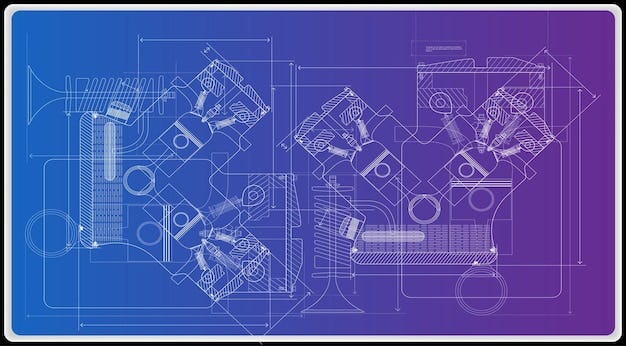Why it's an Engine and not a Copilot
Exploring the AI Engine: A Pragmatic Shift from Copilot to Power Propeller in the Business World.
Imagine you were the pilot of a plane, constantly assisted by a copilot sharing your responsibilities and working in tandem with you. It's an appealing image, isn't it? Now, think of yourself as the driver of a high-performance car, with its masterfully designed engine smoothly firing on all cylinders, powering your journey forward. Both powerful images, but with very different implications - especially when applied to the world of artificial intelligence in business.
We are becoming accustomed to AI being referred to as a 'copilot' for our work, sharing duties and assisting us. But is this metaphor really the best fit, especially when we consider AI's role in the business world? This article takes a critical look at this popular nomenclature, challenging the status quo, and explores why we might be better off thinking of AI as an 'engine' — constantly revving behind the scenes, integrating multiple functions to drive our business forward with greater efficiency.
Many businesses have been using the term “AI Copilot” to describe their AI applications and services. This can be a great choice for a number of reasons:
“Copilot” is a word that is widely recognised, represents a respected occupation and has been (till recently) quite underutilised.
The idea of a personal copilot is one that is easy to digest. “I do the thing. It helps me do the thing.”
Quite distinct from the “assistant” and “chatbot” terminology which are quite tired words that are frankly, boring.
A great example of using copilot as a way of describing AI functionality is the Github Copilot. The branding is brilliant for the tool, making any other AI copilot logos I see pale in comparison. From experience, the copilot analogy works brilliantly for the coding use case. And the numbers speak for themselves.
In 1 year of public availability:
More than 1 million developers
Used by over 20,000 organisations
At least €10 million in MRR
What is interesting however, is that most successful AI products that pitch themselves as a “Copilot” work extremely well in individual/consumer-oriented and B2C contexts. The messaging for this demographic is so great that it's become the default way of describing new AI tools.
What about Business?
The people often in charge of purchasing or introducing new products and applications can oftentimes be detached from its actual use. In the case of AI applications, this is especially concerning as the value these tools provide are often specialised to the end users or can be hard to “get” without an understanding of the work it's trying to optimise.
Employees
For someone concerned with individual growth and efficiency, having a copilot for your work makes perfect sense. A partner to aid with a particularly mind-numbing task is a great value addition. In the real world, copilots are often partnered with a single pilot.
Management
For someone concerned with team growth and efficiency, the analogy of a copilot can be hard to contextualise, especially in large, potentially cross functional, dynamic teams.
A little bit about language use and terminology
A quick summary of some of the terms I’ve used so far and some I will use going forward. A lot of these terms do not have fixed definitions so below are my take on them based on how it's been primarily used in the contexts I've seen.
AI Copilot
An AI copilot can generally be described as an AI powered application that aids and assists human work. This is often in the context of work a single human is doing and the job of the AI copilot is to usually summarise, review and generate suggestions the human can use. Examples of AI Copilots include:
Github Copilot
Jasper
Lex
AI Agent
When googling “What is an AI Agent”, you’ll come across the following definition:
“In Artificial Intelligence, an AI Agent is a computer program that is designed to perceive its environment, make decisions and take actions autonomously to achieve specific goals”
This definition is generally true however it can lead to thinking the terminator is just around the corner. In the context of business oriented AI system, an AI Agent can be simply described as:
“A computer program that focuses on a single task or goal, taking one or many inputs to produce a single, highly grounded and specialised output.”
Orchestration of AI Agents
Individual AI agents are often very good at their jobs. By design. However, it becomes very tempting to tack-on more and more jobs to the agent, allowing/causing it to do more than its specialisation which often reduces its overall quality, efficiency and speed.
A solution is to use an orchestration of multiple highly specialised AI agents to accomplish a given task or problem. The general idea is as follows:
Each agent can do its own task very well
The output of an agent is made available to the others
Agents can pull upon the outputs of the other as needed.
The final output is often of a higher quality, more comprehensive and capable of delivering more value.
How these agents interact with each other depends on the solution being built. Ideas from having the agents debate their solutions to having a schizophrenic AI agent adopt multiple personas have been floated.
So, what is an “AI Engine” then?
An engine is how one would describe this orchestra of specialised AI agents. Being a metaphor for a motor engine, an AI engine describes a complex AI system that takes multiple inputs and is able to produce multiple outputs depending on what its component parts (“AI Agents”) can do. For business and management use cases, this analogy is a lot easier to understand than that of a copilot. Calling back to my earlier example, for someone concerned with team growth and efficiency, utilising an engine to augment the capabilities of your team makes it easier to go from A -> B. Similar to how a car engine makes it easier to go from A -> B.
A key benefit I have noticed while building these AI engines for businesses is that it is much easier for people to devise new improvements, features and solutions to business problems. Being able to visualise their AI engine as a combination of multiple individual specialised agents and knowing what those agents do allows for the following to happen:
Common thoughts and feedback such as: “Perhaps we can have an agent for X or Y!”
The ability to clearly identify and discuss pain points while suggesting well defined inputs and outputs
Businesses discover the nails for your hammer.
Given that we are still in the early days of LLM AI, it's important that businesses are able to understand how this technology is currently able to provide value, but more importantly, what it could be able to do in the future. This is quite difficult to do when working with an AI agent that is effectively an “everything agent” (though usually scoped).
To finish off, I want to give an example of where “AI engine” may be a more valid option than “AI copilot”.
Github Copilot
Github Copilot initially began as an AI copilot that would provide suggestions to Software developers as they wrote code. I would begin to type some code and given the vast wealth of knowledge the model behind the copilot was trained on, it would show me a ghostly suggestion of what it thought I was trying to write. Either speeding me up or making me more certain that AI will not be taking over anytime soon.
As time progressed and the number of developers using the tool increased, calls for new features grew louder and obvious new applications of the technology became apparent. As such, the team at Github began to add new features to the tool under the name “Github Copilot X”, improving its functionality and method of interacting with its users. These features include:
Code focused chat interface
Context aware documentation generator
Context aware test generator
Pull request features on the Github platform
Voice input for coding
Code language translation
And many more!
The range and scope of these features began to touch many platforms and input types, yet are all still branded as being the “Copilot”. Given that there are entire businesses dedicated to some of the features I mentioned above and that each could be shipped as its own product, its seems apt to define each of the above features as its own “AI agent” - taking distinct inputs from the user or other agents, and defining the complete suite of AI tools/agents as an Engine.
However the branding for Github Copilot is quite good and as a dev, I quite like the idea of having my own personal copilot.
Conclusion
As we venture further into the captivating world of LLM AI, I make the case that it is time we reevaluate the labels we've used to depict these revolutionary technologies. The “Copilot”, while a charming analogy, may not fully encompass the multi-faceted capabilities and enormous latent potential within the AI domain for businesses.
Our journey through this nascent technology should be propelled by comprehensive “Engines”, capable of fine-tuning the various cogs of our workflows and seamlessly synchronising multiple tasks. An AI engine, composed of specialised agents, offers the expansiveness and adaptability that modern businesses require to navigate and accelerate in the rapidly evolving digital landscape.
Reframing our view of some applications of AI as an “engine” rather than a “copilot” is more than mere semantics—it's about enhancing our understanding, stimulating innovative thoughts, and opening the doors to a brand new world of AI-driven growth and efficiency. So, are we ready to let our businesses be powered not just by a co-pilot but by a turbocharged AI engine that will redefine the future of work?
Want to learn more about building your organisation AI engine? Get in touch at innovate@kreoh.com.





